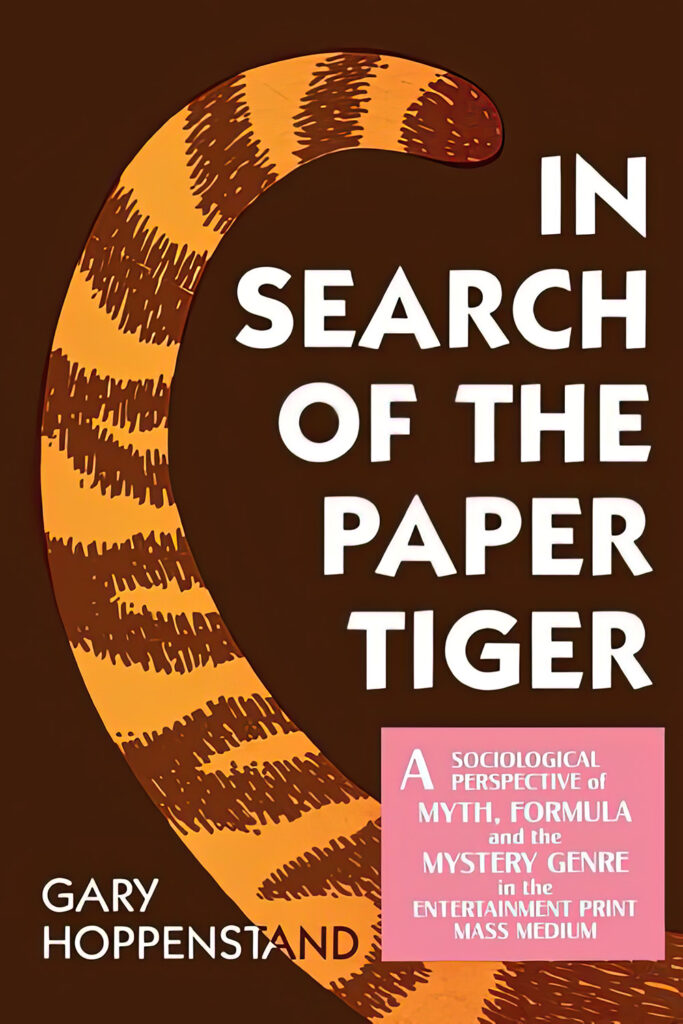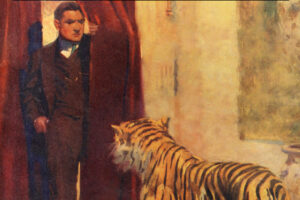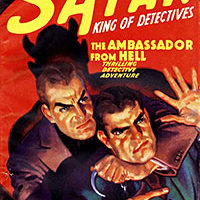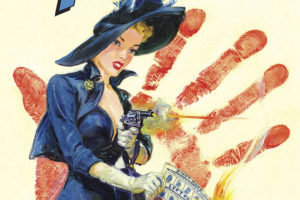An interesting non-fiction work I got recently that was published by Bowling Green State University’s Popular Press is Gary Hoppenstand‘s In Search of the Paper Tiger (1987), subtitled “A Sociological Perspective of Myth, Formula and the Mystery Genre in the Entertainment Print Mass Medium.”
 It’s kind of a mouthful, but it looks at a different method of viewing mystery fiction in popular fiction, of which pulp fiction is a subset. As this blog is focused on pulp fiction, and to a lesser degree dime-novel fiction, I will focus more on that area in this work.
It’s kind of a mouthful, but it looks at a different method of viewing mystery fiction in popular fiction, of which pulp fiction is a subset. As this blog is focused on pulp fiction, and to a lesser degree dime-novel fiction, I will focus more on that area in this work.
Here a hierarchy is used to look at the mystery genre: genre, formula, sub-formula, motif-complex, motif. And there are six formulas looked at:
- supernatural (man against the forces of the universe beyond his understanding)
- fiction (roman) noir (tales of urban pathos and revenge)
- gangster (good and bad organized criminals)
- thief (good and bad individual criminals)
- thriller (includes political suspense stories)
- detective (includes classical, police, hard-boiled, and avenger detective heroes)
All of these are represented in the pulps, though we get examples from all kinds of popular fiction, both before and after pulps. We are also told that the mystery genre is one of three popular fiction genres, alongside fantasy and romantic-adventure. Each of the formulas has its own chapter, where at least a couple of major examples are examined in depth, and others are mentioned.
The supernatural formula is your gothic fiction. And no, we don’t mean the gothic romance. It starts with The Castle of Otranto (1764), continues into Polidori‘s “The Vampyre” where we meet Lord Ruthven. There are three major sub-formulas of this: vampires, werewolves, and ghost tales.
With the pulps, we start to see specialized magazines such as for detective fiction (Black Mask, Detective Fiction Weekly, etc), westerns, and romance. For supernatural fiction, it was mainly Weird Tales, and the top authors were H.P. Lovecraft, Robert E. Howard, and Clark Ashton Smith. Lovecraft’s “Dagon” (1917), his first published story, is heavily discussed here. Next is the “psycho killer,” with heavy mention of Robert Bloch‘s Psycho. Block was a fan of HPL and even wrote some works in Weird Tales.
The fiction noir formula is next, and the author sees it starting in the transition from the dime-novel detectives like Nick Carter to the pulp-magazine detective magazines like Street & Smith’s Detective Story Magazine (continued from Nick Carter’s dime-novel series) and others that followed. Cornell Woolrich (1903-68) is credited with establishing the motifs of this formula in his writings for the pulps. We look at his “Angel Face” (Black Mask, 1937) as an example of this. Then it moves into James M. Cain‘s The Postman Always Rings Twice (1934).
The gangster formula, which is on criminal organizations, in a way came about when Prohibition really made criminal organizations big. This lead to movies about them (the original Scarface, etc), comic strips (Dick Tracy), and pulp magazines devoted to both gangsters and G-men. We take a look at the novel, The Big Shot by Frank L. Packard, better known for The Gray Seal. Next is Mario Puzo‘s The Godfather, which of course spawned more books and movies. Even a new one is out on the making of the movie.
The thief formula, which is on good and bad individual criminals, follows. We start by looking at E.W. Hornung‘s Raffles, the first where the thief is the main character. Raffles is a gentleman thief before others like Arsene Lupin. Then we have Thomas W. Hanshew‘s Hamilton Cleek, the thief who turns good by using his skills to help the police, certainly not the first to do so. Many of the Cleek stories appeared in Short Stories. We get a too-short mention of Packard’s Grey Seal, which I’ve also posted on.
The thriller formula focuses on the spy story. It started in some of the dime-novel series like Old King Brady, which we get some information on. Then moves to works like Ian Fleming‘s James Bond, in particular looking at Casino Royale. Then to John leCarre‘s George Smiley, in particular Call for the Dead. Disappointed that none of the pulp spies are mentioned.
Finally, we get to the detective formula, and we have to start with what is considered the first fictional detective, Edgar Allan Poe‘s C. Auguste Dupin and “The Murders in the Rue Morgue.” Then we move to the police detective with the Memoirs of Eugène François Vidocq. Next is the hard-boiled detective, which came out of Black Mask, in particular the works of Carroll John Daly, especially with his story “Three Gun Terry” (1923). Finally, there is the avenging detective. This starts with dime-novel and later pulp hero Nick Carter, moved to The Shadow, then finally Operator #5.
If you have an interest in mystery or detective fiction, especially within the pulps, I would encourage people to get this volume. It’s not long, 134 pages, and easily available in paperback as it appears to be kept in print via print-on-demand. As pulp fiction is a big part of popular fiction, and many of the formulas of the mystery genre are present in the pulp, this will help you understand how the pulp-fiction mystery and detective work fits in with the rest.
This also brought to my awareness of some characters I hadn’t heard of, which I may look into further, and so will probably revisit this one from time to time as I learn more. This is something we all should do.



